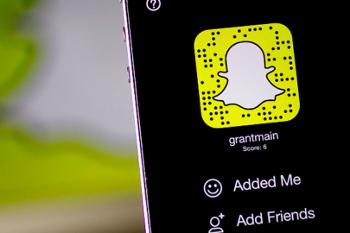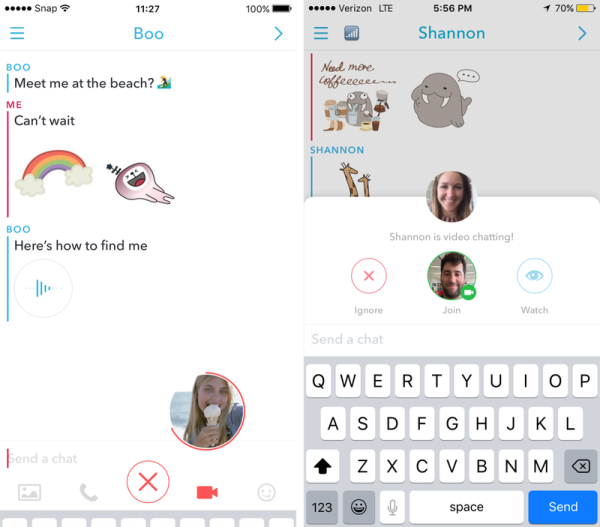Snapchat redesigns chat to add stickers, audio, and video notes

Snapchat is releasing a major update today that bolsters its chat function with a variety of new multimedia features. The long-rumored update adds more than 200 stickers featuring walruses, sloths, aliens, and Snapchat’s signature ghost, and they can be searched by keyword, as on Facebook Messenger. There are also easier controls for starting a video call, allowing you to dial someone who is not present in the chat. You can also choose to chat via audio, and switch back and forth from audio to video during a chat. And if your friend doesn’t pick up, or you just want to send them a reaction using other means, you can record a short audio or video “note” and it will be waiting for them the next time they open the app.
The new chat feature also lets you access your camera roll from the messaging screen for the first time. Tap the familiar photo icon and you can choose to send photos and videos to your friends using chat. You can also access them during video chats, so you can share photos inside the chat even as you talk. (They pop up as large thumbnails on the left side of the screen; when your call ends you’ll find them waiting for you in chat to look at in full resolution.) This feature is unique to the major video chatting services, and helps to answer the question of why you might want to use Snapchat’s video calling feature over FaceTime, Hangouts, Facebook Messenger, or Skype.
SHARE PHOTOS DURING VIDEO CHATS
Snapchat introduced chat in May 2014, allowing users to communicate via text and video chat for the first time. Video chat worked only when both users were present in the chat, and would end if you removed your finger from the screen. (I’m told you could “lock” the video and regain the use of your hand, but I never figured out how.) Since then, other popular messaging clients have continued to add features. Facebook split off Messenger into its own app and added video calling, stickers, and GIF search. WhatsApp added a feature for letting you share documents. iMessage added “tap to talk” for sending audio recordings.

Snapchat is usually content to chart its own path, but it’s not immune to competitive pressures. The company says it has 100 million daily users; WhatsApp and Facebook Messenger draw 900 million and 800 million a month, respectively. (Snapchat has more monthly users than daily users, but hasn’t disclosed the number recently.) And while the company’s unique approach to messaging has made it tremendously popular with younger audiences, it can also make the app feel forbidding for newcomers. (There’s something of a cottage industry in explaining how Snapchat works.)
MORE FAMILIAR — AND MORE ACCESSIBLE
The new chat interface is more familiar — and more accessible. It introduces media seen elsewhere, like stickers, but integrates them in its own unique way. (Send a bunch of stickers to someone and they appear side by side, like words in a sentence.) The company says that the new chat is designed to put every form of input on equal footing, encouraging users to choose whichever one feels natural in the moment. I expect people will get creative with the new tools: video notes in particular, with their 10-second time limit, seem ripe for experimentation.
There are some other nice touches in the redesign. Each chat will show you your most-used stickers for that conversation, making the app feel more personalized. The presence indicator inside chat, which was previously a somewhat ominous pulsating blue square with a white circle inside, has shrunk down to a smiley face that appears when your friend joins. (It then shrinks down further, into a blue dot.) And you can send photos and videos from your camera roll in batches, the kind of power-user feature that makes Snapchat feel more like a grown-up messaging client.
The update also includes a significant change to the Stories feature, which broadcasts your friends’ public snaps for 24 hours after they’re posted. Once you’ve finished watching a story, Snapchat will automatically advance to the next story in your feed. And if you tire of watching one friend’s story, you can now swipe left to see the next story down. (Previously you had to swipe down and then select the next story manually.) The result is an app that now feels a bit closer to television — a “lean-back” experience that encourages you to consume your feed as a single product, rather than as a collection of moments.
In a brief demonstration, the new chat interface looked as fast as ever, but felt just a bit more fun. The update is rolling out today on iOS and Android.











